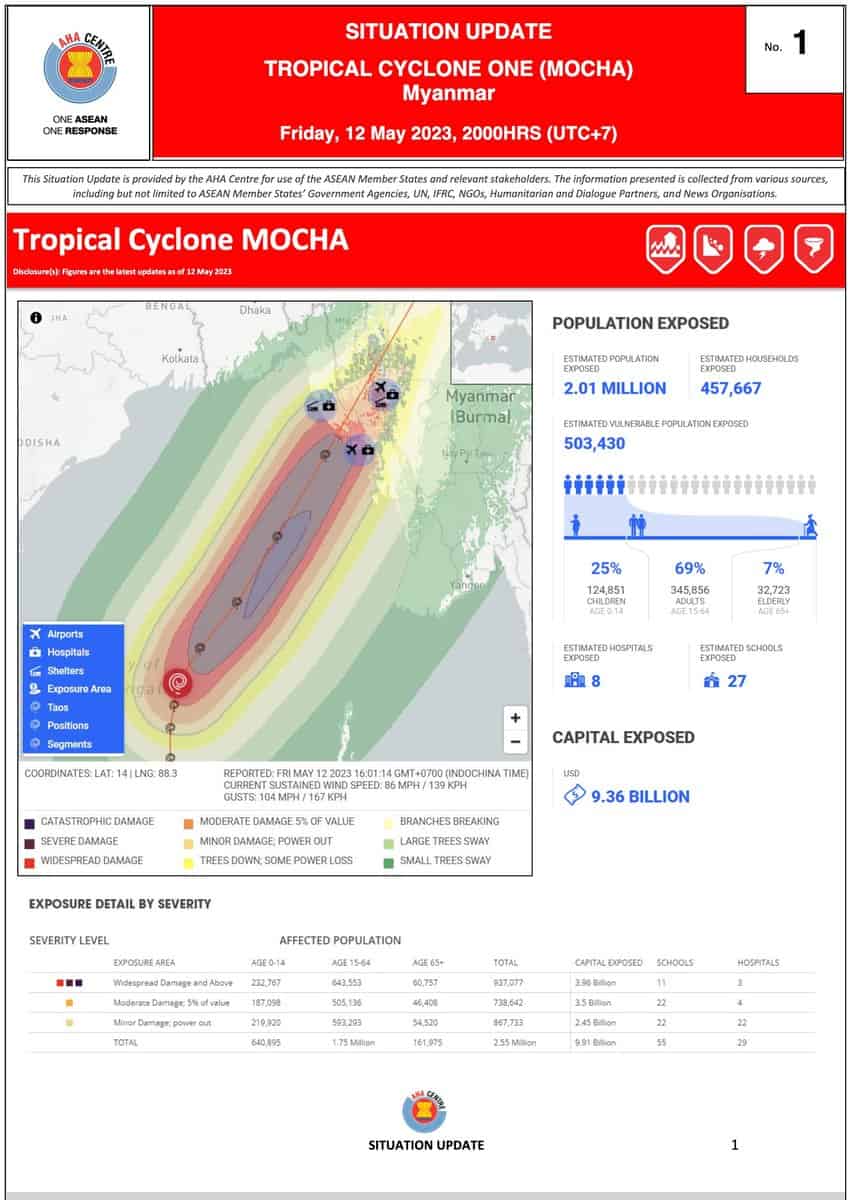Case Study
“We monitored the chronology of the formation of Tropical Cyclone Mocha three days before it landed on the coast of Myanmar. Following the AHA Center SOP, we raised the EOC Activation Level to Yellow (Increased Vigilance) and initiated coordination with Department of Disaster Management (DDM) Myanmar. Simultaneously, we began creating information products in the form of Flash Updates. Additionally, we utilized the impact estimates from the DMRS’s Hazard Brief and Situational Awareness to disseminate relevant information to all stakeholders. This included presenting the information to AHA Centre’s Governing Board.”
–Mohammad Fadli, AHA Centre Liaison


In May 2023, Cyclone Mocha, a powerful and deadly storm in the North Indian Ocean reaching Category 5-equivalent wind intensities, affected several countries including Bangladesh, Sri Lanka, India, and most severely Myanmar.
On May 14, Cyclone Mocha intensified upon encountering warm waters in the Bay of Bengal, making landfall with brutal force in the coastal region of Myanmar’s Rakhine State. As one of the strongest cyclones ever recorded in Myanmar, Mocha brought dangerous winds, heavy rainfall, and storm surge, killing over 100, injuring more than 700, and leaving at least 100 others missing. Mocha destroyed entire townships and communities around the state capital, Sittwe, including Kyauktaw, Maungdaw, Pauktaw, Ponnagyun, and Rathedaung. The storm ravaged homes, schools, religious buildings, medical facilities, airports, and government buildings across the country, leaving hundreds of thousands of people homeless or living in damaged structures.
Several organizations including the World Food Programme (WFP), and the UN Office for the Coordination of Humanitarian Affairs (OCHA), who estimated that potentially 16 million people were affected by the storm including 5 million children, monitored the escalating situation in Myanmar to prepare food, relief supplies and support needs required in the aftermath of Mocha. The ASEAN Coordinating Centre for Humanitarian Assistance on Disaster Management (AHA Centre) provided staff to support the Emergency Operations Center (EOC) in Nay Pyi Taw prior to the cyclone’s landfall and worked closely with OCHA on response throughout the storm.
On May 9, the AHA Centre and the Pacific Disaster Center (PDC) began monitoring Cyclone Mocha. On May 11, through its Disaster Monitoring and Response System (DMRS) and DisasterAWARE platform, PDC issued its first warning of Situational Awareness (SA) on Mocha, including estimated impacts. Utilizing the DMRS’s Hazard Brief, SA, and DisasterAWARE’s Event Brief product, the AHA Centre coordinated and exchanged information on the development of the storm with the Department of Disaster Management (DDM).
As the approaching storm continued gaining momentum, AHA Centre utilized PDC’s DMRS and DisasterAWARE products further, conducting a coordination meeting on May 12 with all related stakeholders including the ASEAN Secretariat, Governing Board, and Myanmar DDM. The meeting aimed to clarify and confirm the situation on the ground, with AHA Centre presenting the summary of their monitoring to the DDM as well as the status of stockpiles in their warehouses in Chai Nat, Thailand, Subang, Malaysia, and in WFP, DDM, and Myanmar Red Cross Society warehouses within the country.
“The ASEAN Disaster Monitoring and Response System (DMRS) is an invaluable tool and platform for Disaster Monitoring and Analysis (DMA) units to perform disaster monitoring and analysis activities. For instance, during the case of Tropical Cyclone Mocha in Myanmar in May 2023, ASEAN DMRS was able to monitor the cyclone’s development in the Bay of Bengal several days before it made landfall on the Rakhine Coast of Myanmar. This information enabled the AHA Centre to also know the extent of the impacts of the winds (TAOS), storm surges, and tropical cyclone-associated rainfall. With this information, the AHA Centre was able to determine its course of action and share it with Department of Disaster Management (DDM) Myanmar to conduct preparedness measures. The advanced analysis with the information from ASEAN DMRS was also shared with the Governing Boards of the AHA Centre, partners, and other relevant stakeholders,” said Sadhu Zukhruf, DMA Officer, AHA Centre
He reiterated how valuable PDC’s technologies and capabilities are to the life-saving work of the AHA Centre, especially while coordinating storm monitoring and response efforts during Cyclone Mocha to minimize impacts on Myanmar’s most vulnerable populations.
With earthquake response operations fully underway, the OCD Operations Center also closely monitored the sinking of the MT Princess Empress oil tanker and the subsequent oil spill that affected Regions IV-A, IV-B, and VI beginning February 28, 2023. The Philippine government continues to coordinate interagency meetings to address the situation that has affected the biodiversity, livelihoods, and tourism of communities within the region. PhilAWARE has played an integral role in mapping the extent of the oil spill with leadership and response stakeholders. As of July 2023, the hazard remains active, and PhilAWARE continues to provide critical information such as situation reports and analysis by the OCD Team.
 | ASEAN | Regional and National Capacity Development for Hazard Monitoring, Early Warning and Disaster Management Decision Support
| ASEAN | Regional and National Capacity Development for Hazard Monitoring, Early Warning and Disaster Management Decision Support
Want to speak with someone about our capabilities or DisasterAWARE technology?
 AHA Centre aids response to Cyclone Mocha in Myanmar using DMRS—a custom version of DisasterAWARE
AHA Centre aids response to Cyclone Mocha in Myanmar using DMRS—a custom version of DisasterAWARE